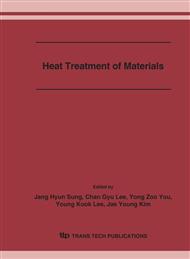p.35
p.41
p.47
p.53
p.59
p.65
p.71
p.77
p.85
Microstructural Change and Martensitic Transformation in a Rapidly Solidified Cu-Al-Ni Based SMA Ribbons with Heat Treatment
Abstract:
The effects of flash-heating and aging on the microstructure and transformation characteristics has been studied in Cu-Al-Ni based melt-spun ribbons. When the as-spun ribbon, stabilized due to higher Al content and fast cooling, is flash-heated at 750 °C, the β1 parent phase is partially retained. Even though flash-heating temperature is increased upto 850 °C, a little β1 parent phase with lager grains above 10 μm is still retained. The Ms temperature is increased with increasing flash-heating temperature due to the decrease of grain constraint within grown grains. However, the greater part of β1 parent phase with smaller grains of 2 ~ 3 μm is transformed to martensite in the initial stage of aging at 200 °C. The Ms temperature of the ribbon with smaller grains is higher than that of the ribbon with larger grains. It is considered that the increase of Ms temperature is caused to the disappearance of lattice defects introduced during melt spinning by aging at 200 °C rather than grain growth.
Info:
Periodical:
Pages:
59-64
Citation:
Online since:
December 2006
Authors:
Price:
Сopyright:
© 2006 Trans Tech Publications Ltd. All Rights Reserved
Share:
Citation:


